The Beginner's Guide to SEO
Rankings and traffic through search engine optimization
Introduction
Welcome to your SEO learning journey!
You'll get the most out of this guide if your desire to learn search engine optimization (SEO) is exceeded only by your willingness to execute and test concepts.
This guide is designed to describe all major aspects of SEO, from finding the terms and phrases (keywords) that can generate qualified traffic to your website, to making your site friendly to search engines, to building links and marketing the unique value of your site.
The world of search engine optimization is complex and ever-changing, but you can easily understand the basics, and even a small amount of SEO knowledge can make a big difference. Free SEO education is also widely available on the web, including in guides like this! (Woohoo!)
Combine this information with some practice and you are well on your way to becoming a savvy SEO.
The basics of search engine optimization
Ever heard of Maslow's hierarchy of needs? It's a theory of psychology that prioritizes the most fundamental human needs (like air, water, and physical safety) over more advanced needs (like esteem and social belonging). The theory is that you can't achieve the needs at the top without ensuring the more fundamental needs are met first. Love doesn't matter if you don't have food.
Our founder, Rand Fishkin, made a similar pyramid to explain the way folks should go about SEO, and we've affectionately dubbed it "Mozlow's hierarchy of SEO needs."
Here's what it looks like:
Try Moz Pro, free!
As you can see, the foundation of good SEO begins with ensuring crawl accessibility, and moves up from there.
Using this beginner's guide, we can follow these seven steps to successful SEO:
- Crawl accessibility so engines can read your website
- Compelling content that answers the searcher’s query
- Keyword optimized to attract searchers & engines
- Great user experience including a fast load speed and compelling UX
- Share-worthy content that earns links, citations, and amplification
- Title, URL, & description to draw high CTR in the rankings
- Snippet/schema markup to stand out in SERPs
We'll spend time on each of these areas throughout this guide, but we wanted to introduce it here because it offers a look at how we structured the guide as a whole.
Explore the chapters:
Quick Start SEO Guide
Speed up to catch up
Go from zero to hero with our step-by-step refresh on the core fundamentals for setting your site up for SEO success.
Chapter 1: SEO 101
What is it, and why is it important?
For true beginners. Learn what search engine optimization is, why it matters, and all the need-to-know basics to start yourself off right. Download your free Quick Start Worksheet.
Chapter 2: How Search Engines Work – Crawling, Indexing, and Ranking
First, you need to show up.
If search engines literally can't find you, none of the rest of your work matters. This chapter shows you how their robots crawl the Internet to find your site and add it to their indexes.
Chapter 3: Keyword Research
Understand what your audience wants to find.
Our approach targets users first because that's what search engines reward. This chapter covers keyword research and other methods to determine what your audience is seeking.
Chapter 4: On-Site Optimization
Use your research to craft your message.
This is a hefty chapter, covering optimized design, user experience, information architecture, and all the ways you can adjust how you publish content to maximize its visibility and resonance with your audience.
Chapter 5: Technical SEO
Basic technical knowledge will help you optimize your site for search engines and establish credibility with developers.
By implementing responsive design, robot directives, and other technical elements like structured data and meta tags, you can tell Google (a robot itself) what your site is all about. This helps it rank for the right things.
Chapter 6: Link Building & Establishing Authority
Turn up the volume.
Once you've got everything in place, it's time to expand your influence by earning attention and links from other sites and influencers.
Chapter 7: Measuring, Prioritizing, & Executing SEO
Set yourself up for success.
An essential part of any SEO strategy is knowing what's working (and what isn't), adjusting your approach as you go along.
The SEO Glossary
Understand key terms and phrases.
Learning SEO can sometimes feel like learning another language, with all the jargon and industry terms you're expected to know. This chapter-by-chapter glossary will help you get a handle on all the new words.
Quick Start SEO Guide
SEO isn’t hard, but it can take time to master many of the more advanced areas. In the meantime, you want to ensure you're set up with all the essential SEO fundamentals so you're best placed to capitalize on your results sooner rather than later, with this Bonus SEO Quick Start Guide.
Fortunately, when you are beginning, there are basic practices you can take to cover the bases. Following these simple steps will help you avoid common SEO pitfalls, and set you on the path to success. They'll also provide a starting point to learn the fundamentals, so you can raise your SEO traffic levels to new heights down the road.
We'll cover these points in more depth throughout the Beginner's Guide to SEO (and other places on Moz) but for now, let's get started.
1. Gather Your SEO Data
To do SEO you really only need 3 things to get started: a website, your brain, and data.
Hopefully, you already have the first two, so let's make sure you have the right data.
Data is everywhere in SEO, from visitor analytics to keyword research, and especially link building. Your most important data is going to come from your website itself. To this end, we recommend making sure you have the following data sources set up.
✅ Install Analytics
Web analytics gives you information about who visits your site, how much traffic you receive and from where, what pages people visit, how they engage with your content, and more.
Google Analytics is by far the most popular analytics platform. Most SEOs install it by default. You should note that Google is transitioning to a new type of analytics known as GA4. If unsure, you can simply follow Google's instructions to set up both Universal Analytics (traditional) and GA4 at the same time (at least until Google deprecates Universal Analytics.)
If you'd rather not use a Google product, many alternatives exist such as Matomo, Statcounter, and more.
✅ Register With Search Engines
Search engines like Bing and Google offer a wealth of information about your website that you simply can’t get anywhere else. This data often includes the keywords you rank for in search, how each search engine crawls your site and more.
Two of the most popular search engine analytics services are:
To be clear, registering your site with search engines doesn’t necessarily get you more traffic, but it can give you access to special tools to help you get there.
✅ Recommended: Run a Crawl
While not required, we highly recommend you run a crawl of your website in order to highlight SEO issues that may not be obvious. This will also help you see your site like a search engine does.
A good SEO audit tool such as Moz Pro’s Site Crawl will find issues such as broken pages, links that don’t work, duplicate content issues, and other technical SEO problems. Other good crawlers we recommend include Screaming Frog and Sitebulb.
Get your free Moz Pro training
Duplicate Content Solutions — Whiteboard Friday
Learn how to resolve duplicate content issues with Meghan, or dive into more Whiteboard Friday episodes.
2. Check How Your Site Is Indexed
To be eligible to show up in search results, the pages of your site first must be “indexed” by search engines. Indexing basically means a search engine has crawled a page and made a record of its content. (Sometimes search engines may rank a page even if it can’t crawl it, but this is much rarer.)
✅ Perform a site: search
The simplest way to check if a site or page is indexed is to perform a site: search. This works for both Google and Bing. For example, if you wanted to check the index status of moz.com, you’d type the following into Google’s search box.
site:moz.com
This will also tell you approximately how many pages Google has indexed. In this case, we see tens of thousands of pages.
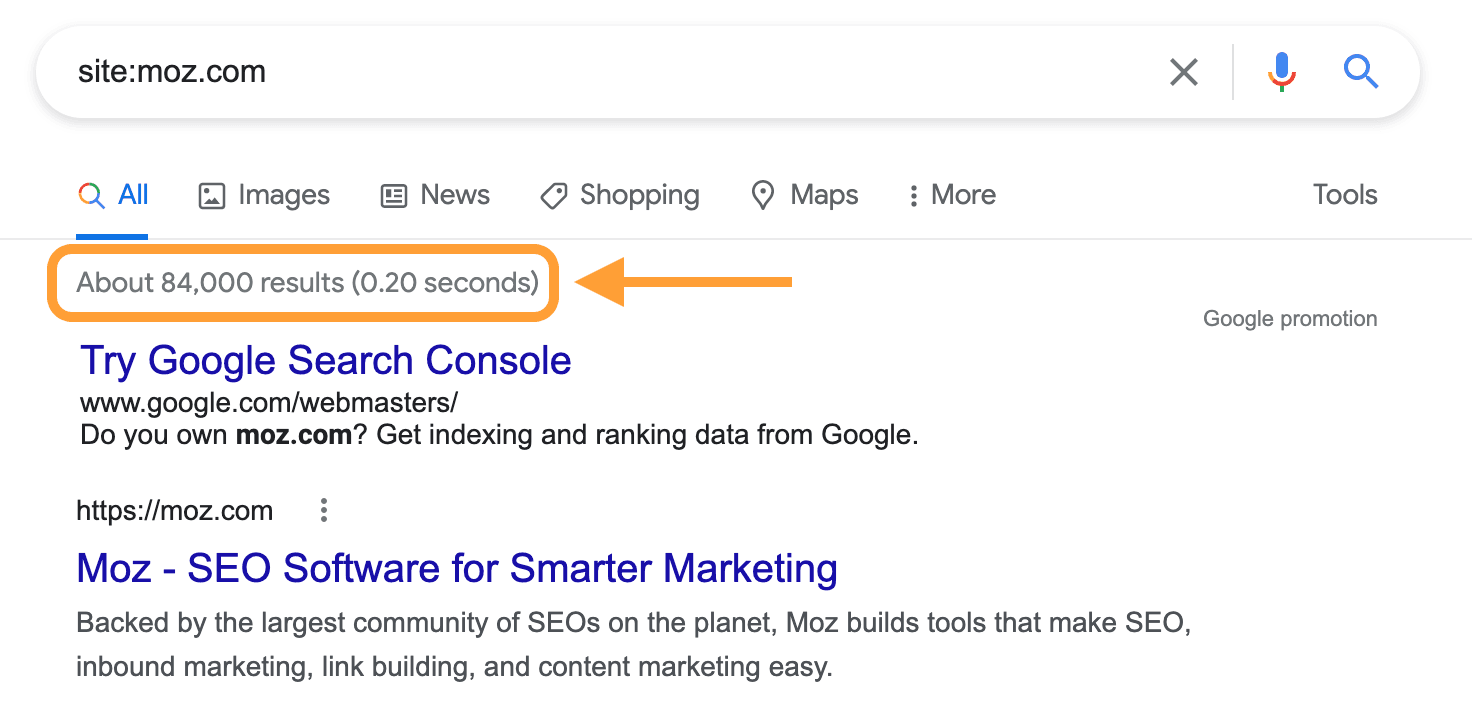
You can also check if individual pages are indexed, like this:
site:moz.com/learn/seo/domain-authority
If Your Site or Page Isn’t Indexed
If you find your site isn’t indexed, there are typically a few areas to check and questions to ask yourself.
✅ Is the site brand new?
It takes time for search engines to crawl and index sites, so new sites or pages may not show up right away.
✅ Does the site offer unique, valuable content?
Ask yourself if the site is truly worthy of appearing in search results. In other words, is it uniquely valuable? Spam, non-original, or low-value content may be excluded by search engines by default.
✅ Is the site crawlable and indexable?
Here we’re going into a bit of Technical SEO. If you believe a site/page should be indexed, and it’s not, there are a few basic steps you can perform.
First, you want to check your Site Crawl and/or Google Search Console.
If you performed a site crawl using a recommended SEO tool (step 1) it should highlight any major issues that might prevent your site from being indexed.
Similarly, you can enter a URL into Search Console’s URL Inspection Tool. If the URL is not on Google, hit the “Test Live URL” button for a diagnostic report.
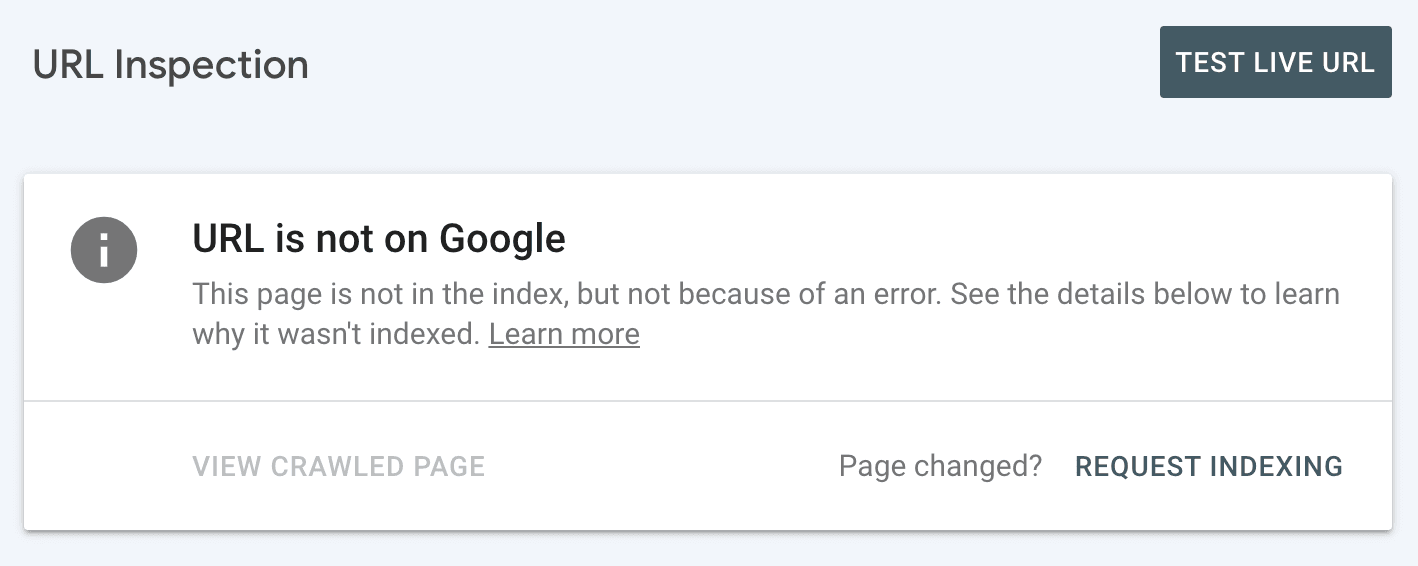
Common Technical Indexing Problems
Your crawl report and/or Google Search Console may report any number of issues with your page that could impact how it may appear in search.
The page isn’t crawlable and/or doesn’t return a 200 status code. Learn more about HTTP Status Codes.
Robots meta directive doesn’t allow indexing. Learn more about robots meta tags.
Page is blocked by robots.txt. Learn more about robots.txt.
Page isn’t listed in the sitemap file. Sitemap files aren’t required for crawling and indexing, but they can help search engines discover your content. Learn more about sitemaps.
Duplicate content issues. If the same content lives in multiple places, it can impact visibility in search. Canonicalization is one way to solve this problem, though there are other methods as well. Learn more about duplicate content.
✅ Mobile Check: See Your Site Like a Search Engine
We can’t stress this point enough: while your site might look excellent when you view it in your web browser, you can’t always trust your eyes. Search engines aren’t human, and things like JavaScript or mobile versions of your site may sometimes trip them up.
Looking at your site like a search engine does help ensure that the important content on your site gets crawled and indexed properly.
Perhaps most important is how your site performs on mobile devices. While you may look at your site on a desktop computer, the majority of web users now access most sites through search via their phone. For this reason, Google typically considers the mobile version of your site for ranking purposes.
For a quick look at how search engines see the mobile version of your site, you can try Google's Mobile-Friendly Test.
3. Target Specific Keywords
The magic of SEO is that people can find your content the exact moment they search for an answer using a search engine. If your content provides an above-average, targeted answer to a specific search query, you have a good shot of ranking and earning the click.
But first, you need to know exactly what people are searching for, e.g. the “keywords” they use.
Beyond that, you want to know if enough people are searching for something to make it worth your time to create content, and how difficult it might be to actually rank for those keywords.
Keyword research is a big topic in SEO. While it can take a long time to master, there are a few simple steps to get you up and running:
✅ Discover Keywords You Already Rank For
Knowing what keywords and phrases you already rank for is often a good starting point before you begin optimizing for new keywords. Enter your domain into Keyword Explorer to see all of your top-ranking keywords by search volume.
Find rankings keywords
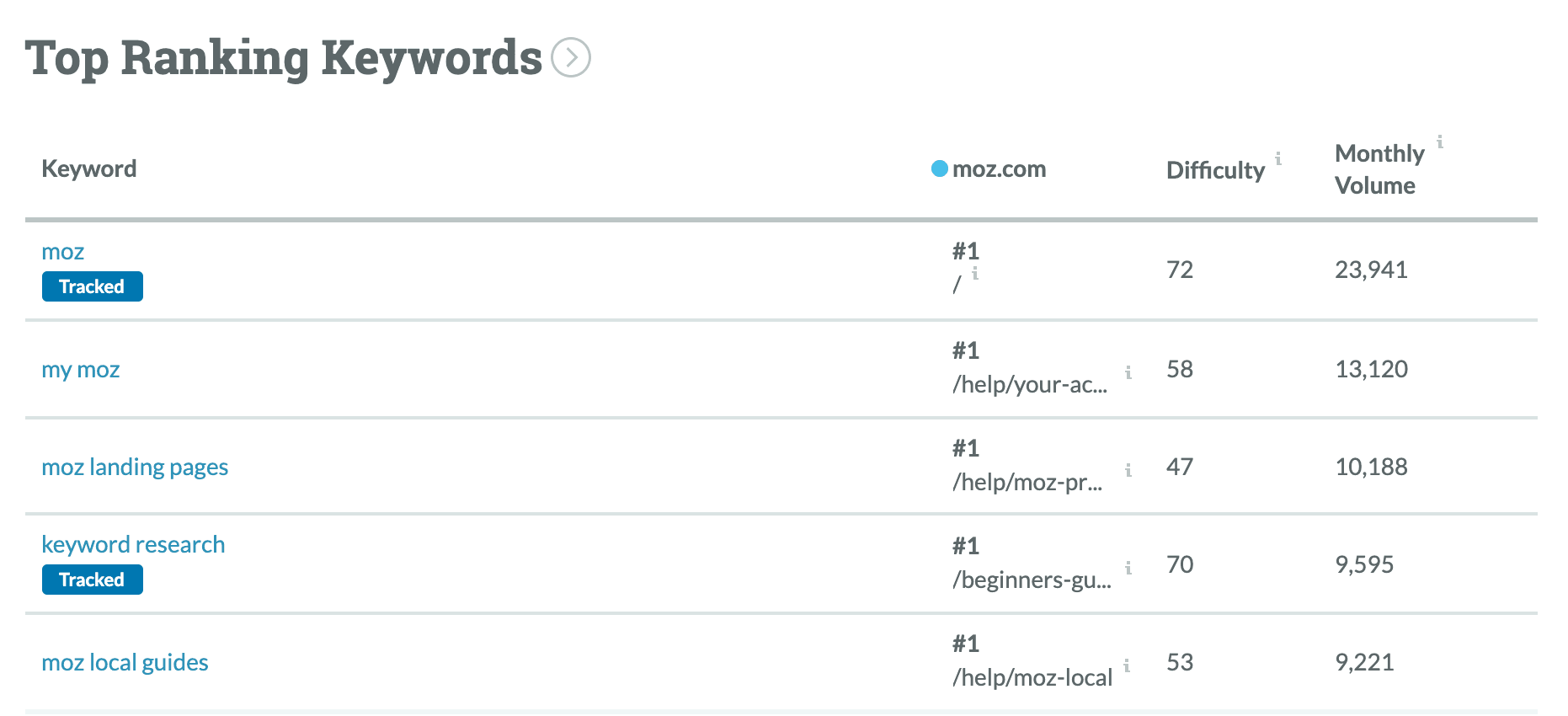
Another great place to find keywords you already rank for is Search Console’s Performance Report.
✅ Find Keywords Related To Your Topic
The next step is to find keywords that you might want to target. Again, we go into the details of this in our Keyword Research Master Guide, but to oversimplify, you’ll want to find keywords that:
Have sufficient search volume
Aren’t too difficult for you to rank for
Are relevant to your business
Use “seed keywords” in your favorite keyword research tool to build out a list to target.
✅ Target Keywords On Your Page
Once you know what keywords your content targets, it’s important to actually incorporate those keywords, topics, and related concepts onto your page. Obvious places to place your important keywords include your title tag, meta description, headline, paragraph headers, and body text. Here’s a few more ideas for incorporating keywords into your on-page optimization.
Be sure not to overdo it, as you want to avoid keyword stuffing.
4. Optimize Your Search Appearance
When you rank in search, Google (and other search engines) takes elements of your page to display in search results. These elements can not only influence how many people click on your result, but in some cases, they can also influence how well you rank.
Optimizing your search appearance is an important part of SEO. Here’s a quick breakdown of the major elements you should consider: title tags, meta description, breadcrumbs, rich snippets, and favicons.
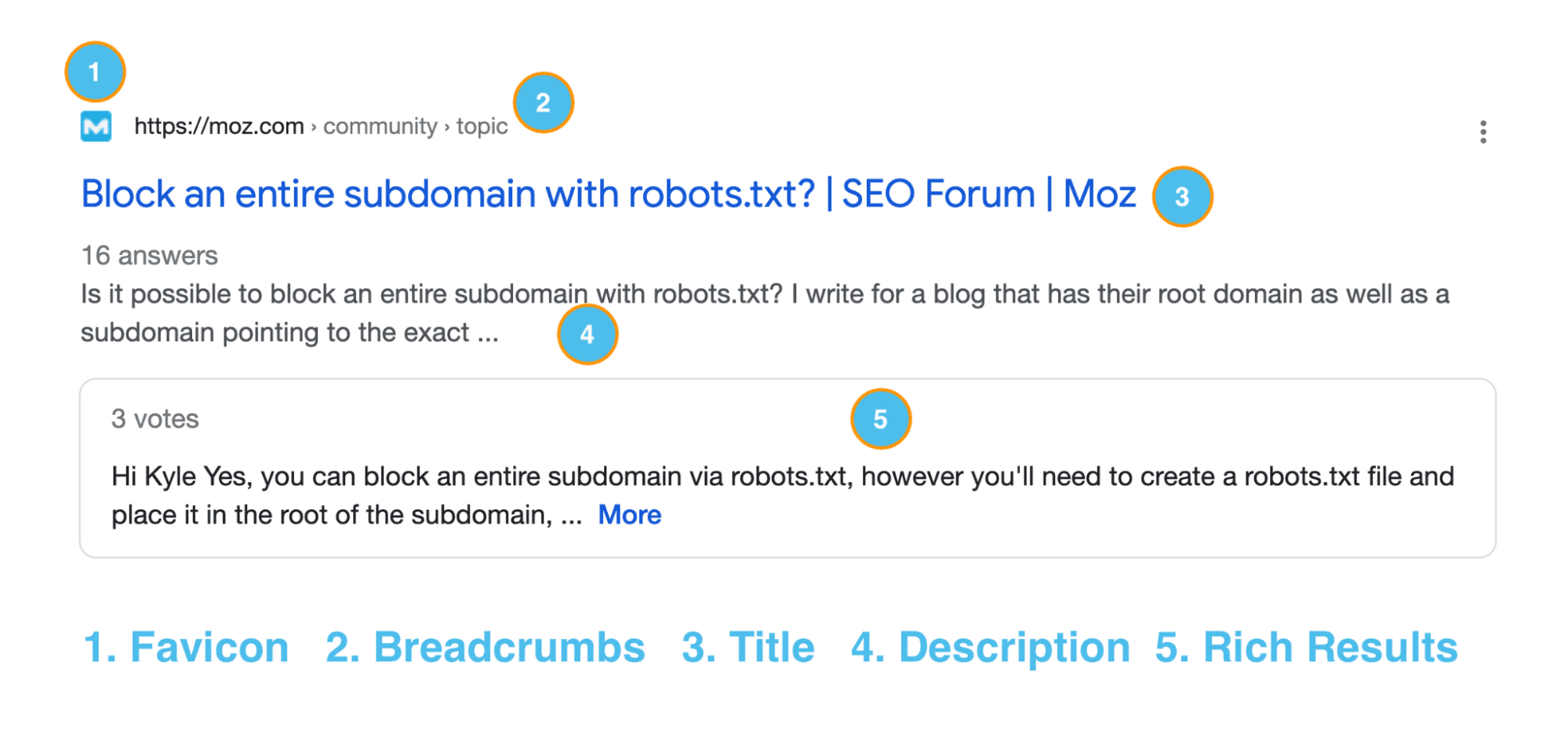
Each of these is important in its own right, so let's go over each in turn.
4a. Write Descriptive, Click-Worthy Title Tags
Title tags might be the most impactful part of your search appearance, and they’re also a small ranking factor! Google is known to rewrite a lot of title tags, but there are a number of best practices you can use to help your SEO.
✅ Write Unique, Accurate Titles for Each Page
Avoid using the same title on multiple pages. Make sure you create descriptive, unique titles that accurately describe what a visitor will find on the page.
✅ Use Keywords In Your Titles, But Don’t Overdo It
Using keyword research (which we’ll cover below) make sure your titles contain the keywords users are likely searching for when your page appears in search results. Use a tool like Google Search Console or Keyword Explorer to find out what keywords a URL is already ranking for.
Note: Google is more likely to rewrite page titles that repeat the same keywords, so using a keyword once is typically enough.
✅ Aim For Between 50-60 Characters (& Maybe More for Mobile)
Google will often rewrite titles that are either too long or too short. On desktop, the “sweet spot” is typically between 50-60 characters. You can check title length using this length checking tool.
If your title is too long, it’s best to keep your important keywords visible near the front. Mobile results are often longer, so if you know that most of your search comes from mobile devices, it’s often okay and workable to have longer title tags.
4b. Create Descriptive Meta Descriptions
To be clear, meta descriptions don’t count as a Google ranking factor. Also, Google is known to not use a site’s meta description much of the time. That said, using unique, well-written meta descriptions can have a positive impact on the number of clicks you ultimately receive.
✅ Write Unique, Compelling Descriptions for Each Page
Google likes unique meta descriptions, so don’t reuse the same description across multiple pages. While there’s no limit on length, Google usually truncates descriptions between 150-160 characters (sometimes longer) so make sure to stay within reasonable limits.
✅ Use Keywords In Your Meta Descriptions
Your meta descriptions should offer a compelling reason for users to click your results. Good copywriting is key! A dead-simple way to do this is to use important keywords in your description. When the keywords in your description match the user query, Google will highlight these words in your description, thereby helping it to stand out.

Learn more about meta descriptions.
4c. Use Structured Data for Rich Results
Rich results are special features in search results that go beyond title and meta descriptions and include things like review stars, images, FAQs, and more. You can explore Google’s supported rich results here.
Rich results are most often triggered by structured data. Most modern content management systems include support for some type of structured data by default (such as Yoast or Rankmath for WordPress.)
✅ Use Structured Data on All Your Pages
At a minimum, schema types such as Article or Product offer basic markup for the majority of pages. Other schemas may be more appropriate for your individual circumstances. The more specific information you can offer—such as author, dates, prices, etc.—the better off you’ll be.
✅ Validate Your Structured Data
Because it’s easy to mess up, it’s important to verify your structured data using a tool specially built for the purpose. Two of our favorites are the Schema Markup Validator and Rich Results Test.
4d. Define Your Breadcrumbs
Breadcrumbs might seem like a tiny part of Google search, but they can have a significant impact on your overall traffic. Experiments have shown that there’s no right answer when it comes to breadcrumbs, but typically, having a compelling, keyword-rich structure is known to help.
✅ Use Breadcrumb structured data
Using structured data is the most straightforward, least ambiguous way to define your breadcrumbs to Google. Be sure to validate your results using one of the validators mentioned above.
✅ Use A Clear, Keyword-Focused URL Structure
Oftentimes—especially on mobile or when structured data isn’t present—search engines will use your URL structure to define breadcrumbs, for example, if our URL was:
https://moz.com/seo/tools/keyword
Google might display the following breadcrumbs:
https://moz.com > seo > tools > keyword
Note: More on URL structure is covered below in section 6. Internal Links & Site Architecture.
4e. Stand Out With a Favicon
Favicons are little icons that appear next to your Google listing on mobile. While small, using an attractive, eye-catching favicon can help make your listing stand out. A single favicon is defined across your entire site.
✅ Define Your Favicon
Define a “shortcut icon” in the <head> of your home page that points to your favicon like this:
<link rel="shortcut icon" href="/favicon.ico">
While no one favicon works best, favicons that are high-contrast and work with your brand are usually the way to go.
5. Create Content Like a Boss
SEO is about more than putting keywords on your page (a lot more!) How your page is structured, its relevance to the query, and how it satisfies user intent goes a long way in helping you to rank and attract visitors.
Here's a few basic steps to point you in the right direction.
✅ Start With User Intent
Beyond keywords, does your content give users what they're looking for? If they search for "shaggy cat" do you know if they want pictures of shaggy cats, how to adopt shaggy cats, or maybe how to groom shaggy cats? A good place to start is by looking at current search results, and seeing what already ranks highly.
Remember, the goal isn't to copy your competitors, but to use the results shown as a clue towards what Google might be looking for, and satisfy user intent even better so you deserve to rank even higher.
✅ Use Headers and Subheaders
Breaking up your content using headlines and subheaders (H1, H2, etc.) not only helps readers digest your content, but helps Google understand it as well!
A good SEO practice is to think of your content like an outline, and break it into logical sections as appropriate.
✅ Use Images Wisely
Google is getting better and better at understanding images, but they still can't "see" images like a human. Because of this, there are a few SEO best practices to keep in mind:
Don't rely on images for important text. It's fine to use text in images, but don't expect search engines to be able to "read" image text like a human. Use text (like this) for text.
Use alt text. Alt text helps search engines and screen readers understand your images. It's also important when you link your images.
<img src="pupdanceparty.gif" alt="Puppies dancing">
Overly large image files can slow down your website speed and even your rankings. Properly size your image and define your dimension. Optimize your images for the best possible chance of ranking.
Visual Search Optimization — Whiteboard Friday
Learn all about visual search optimization with Crystal, or dive into more Whiteboard Friday episodes.
✅ Keep Your Content Relevant and Fresh
Content freshness, in different forms, is an actual Google ranking factor. Don't let your content go stale, and make sure to update your content regularly to keep it relevant. Not every piece of content needs updating for freshness sake, but if your out-of-date content isn't as good as the competition, consider a content refresh.
✅ Optimize for User Satisfaction
Your primary goal in creating content that attracts SEO traffic is to satisfy the user. The best way to do this is to make sure they don't want to go back to Google and click on another result.
This is known as "be the last click." There's evidence that satisfying the user in this way can actually boost your rankings, so strive to make it your number one goal!
6. Internal Links & Site Architecture
Links (like this) work as the glue to hold the internet together. Links also help search engines to discover, crawl, and rank your web pages. When a page is linked to a lot by other pages, this can signal its importance to search engines.
Internal links, or links from your own site, can act as strong hints to Google to crawl, index, and ultimately rank your pages
✅ Use A Clear And Helpful Navigation
Users, and search engines, should be able to tell where they are on your site, and how to navigate to other pages. You can accomplish this by incorporating:
A clear navigation that links to your most important pages
Breadcrumbs
Related links

✅ Make Sure All Important Pages Are Linked
Make sure you don't have "orphaned" pages - pages that aren't linked to from anywhere else on your site. Ideally, visitors should be able to navigate from your homepage to any other page on your site with only a handful of clicks.
Note: For very large sites, pages should still be linked, but the "handful" of clicks may be a difficult rule to strictly follow. In these cases, XML sitemaps are your friend.
✅ Use Descriptive and Unique Anchor Text
Anchor text refers to the words you use when you link. In code, it looks like this:
<a href="">Example Anchor Text</a>
Anchor text can be used by search engines to determine what a page is about (relevancy) and for ranking purposes. For example, if we link to one of our MozCon pages using the anchor text "marketing conference," Google might correctly understand this page has something to do with marketing conferences, and rank the page higher for those types of queries.
Note: While anchor text from external links is considered a much stronger signal, your own internal links can still carry significant weight when used appropriately. Be careful not to overdo it, as over-optimizing your anchor text can lead to negative consequences.
✅ Employ A Logical URL Structure
Google and other search engines can often understand your site better when it's properly organized with a good URL structure.
For example, if your site sells electronics, and many of these are televisions, it may make sense to put all TVs in this category in a television directory, like this:
https://example.com/televisions/awesome-tv-brand
In general, it's best practice for your URL to match your site structure, much like your navigation.
7. Gaining Popularity Through Link Building
Here's a truth about SEO: popular sites typically rank higher.
So how do search engines determine popularity? One way is by looking at who links to you.
While internal links are important, external links are what can really boost your ranking potential. In fact, it's extremely difficult to rank without external links, and the top sites on the internet are typically the ones with the most number of high quality links.
✅ See Who's Already Linking To You
A good place to start with link building is to find out who already links to you. This can help inform your decisions down the road, and give you a relative sense of strength.
Using a good backlink checker such as Link Explorer, you can easily find what sites on the internet, if any, have already linked to your site.
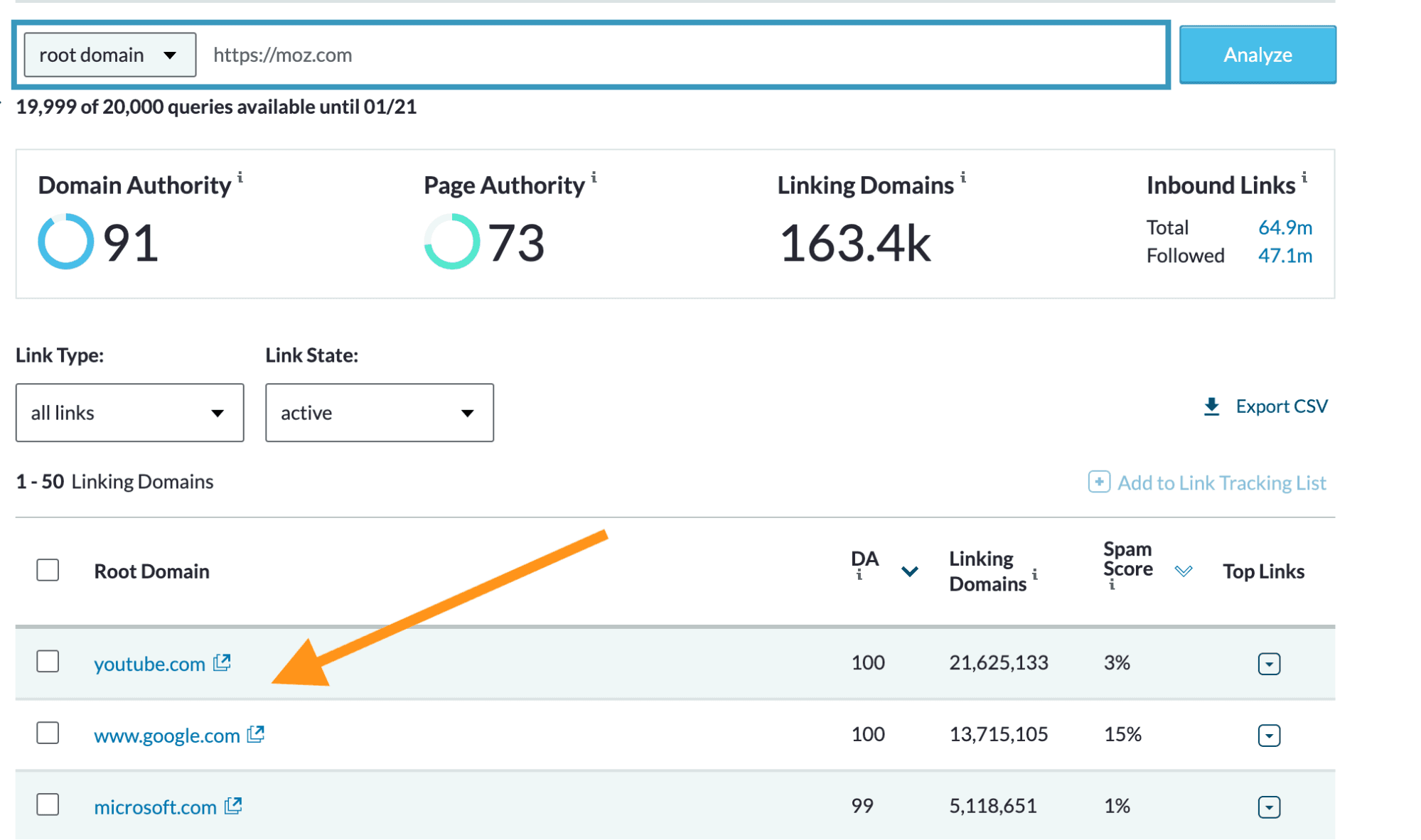
Backlink analysis like this can also help identify what content on your site is the most successful at attracting links, which can inform your content strategy.
✅ Find Out Who Links to Your Competitors
Getting others to link to your site can be difficult, but one of the easier ways to get links is to scope out your competitors, and find out who's linking to them.
To do this, it's important to understand who your actual online competitors are. If you run a real-world business, your online search competitors are often very different than your real-world ones. Tools like Domain Analysis can help you figure out who your real competitors are.
Once you know who your competitors are, use the same tools used to find your own links and find out who is linking to your competitors. See what type of content earns your competitors the best links. These bits of information can help you formulate your own link-earning strategy.
Learn more about competitive link analysis
🚫 Avoid Shady Link Practices
While Google rewards links, it discourages manipulative link building. For this reason, Google tends to favor editorial links: those links freely given by human editors without manipulation.
This means Google frowns upon:
Paid links
Self-placed links (e.g. spammy comment links)
Affiliate or advertising links placed without disclosure. See: ugc and sponsored links.
These types of links are often ignored, and can even get you penalized. In general, the easier a link is for anyone to get, the less likely Google is to value it.
Learn more about link schemes to avoid.
✅ Promote Your Site And Your Best Content
Don't let manipulative link building scare you. The best SEOs and content marketers actively build links to their best content. To stay on Google's good side, this can be done in a safe, editorial friendly way that makes the Internet a better place.
There are many link building strategies you can employ, but most of them simply involve letting potential linkers know about your content. This might mean sharing your content on social media, running a focused PR campaign, or performing outreach to specific bloggers or journalists.
Some common link building tactics include:
Contributing to respected publications
Content based link building
Broken linking building
… and many more. The key to successful link building is to make sure your content is worth linking to (is it truly the best of its type on the internet?) and forming good relationships with those that might want to link to you.
Learn more about link building.
That concludes the SEO Quickstart Guide! If you want to dive deeper, we have much more to explore.
How much more of this guide do I need to read?
Wow, you've already achieved so much, thanks for sticking with us while we blasted through the bonus Quick Start Guide to SEO.
If you're serious about improving search traffic we do recommend reading the Beginner's Guide to SEO front-to-back. We've tried to make it as concise and easy to understand as possible, and learning the basics of SEO is a vital first step in achieving your online business goals.
Go through at the pace that suits you best, and be sure to take note of the dozens of resources we link to throughout the chapters — they're also worthy of your attention.
If you want to take a more guided approach to learning SEO or training your entire team, check out the Moz Academy SEO Essentials Certification. We've consolidated all the resources you need to learn SEO fundamentals alongside unique learning strategies, task lessons and quizzes to test your knowledge. You can also display your knowledge with your Linkedin Moz SEO Essentials certification badge.
Getting excited yet? You should be! Without further ado, let's launch into Chapter 1 (SEO 101).